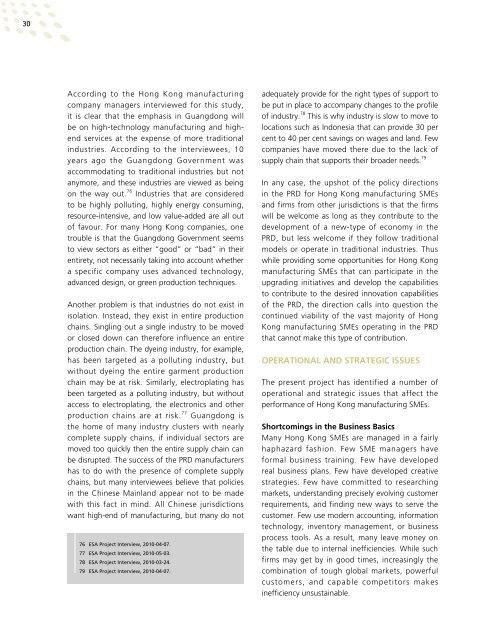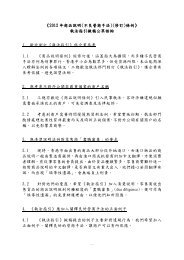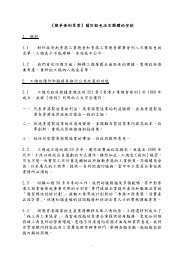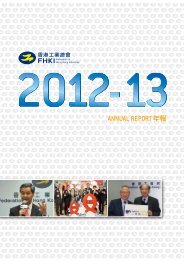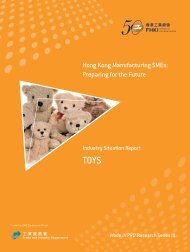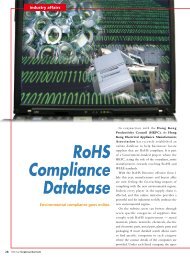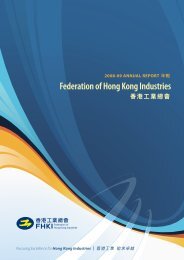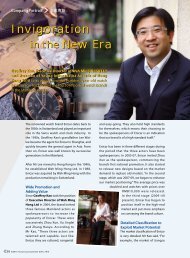Hong Kong Manufacturing SMEs: Preparing for the Future
Hong Kong Manufacturing SMEs: Preparing for the Future
Hong Kong Manufacturing SMEs: Preparing for the Future
- No tags were found...
You also want an ePaper? Increase the reach of your titles
YUMPU automatically turns print PDFs into web optimized ePapers that Google loves.
30According to <strong>the</strong> <strong>Hong</strong> <strong>Kong</strong> manufacturingcompany managers interviewed <strong>for</strong> this study,it is clear that <strong>the</strong> emphasis in Guangdong willbe on high-technology manufacturing and highendservices at <strong>the</strong> expense of more traditionalindustries. According to <strong>the</strong> interviewees, 10years ago <strong>the</strong> Guangdong Government wasaccommodating to traditional industries but notanymore, and <strong>the</strong>se industries are viewed as beingon <strong>the</strong> way out. 76 Industries that are consideredto be highly polluting, highly energy consuming,resource-intensive, and low value-added are all outof favour. For many <strong>Hong</strong> <strong>Kong</strong> companies, onetrouble is that <strong>the</strong> Guangdong Government seemsto view sectors as ei<strong>the</strong>r “good” or “bad” in <strong>the</strong>irentirety, not necessarily taking into account whe<strong>the</strong>ra specific company uses advanced technology,advanced design, or green production techniques.Ano<strong>the</strong>r problem is that industries do not exist inisolation. Instead, <strong>the</strong>y exist in entire productionchains. Singling out a single industry to be movedor closed down can <strong>the</strong>re<strong>for</strong>e influence an entireproduction chain. The dyeing industry, <strong>for</strong> example,has been targeted as a polluting industry, butwithout dyeing <strong>the</strong> entire garment productionchain may be at risk. Similarly, electroplating hasbeen targeted as a polluting industry, but withoutaccess to electroplating, <strong>the</strong> electronics and o<strong>the</strong>rproduction chains are at risk. 77Guangdong is<strong>the</strong> home of many industry clusters with nearlycomplete supply chains, if individual sectors aremoved too quickly <strong>the</strong>n <strong>the</strong> entire supply chain canbe disrupted. The success of <strong>the</strong> PRD manufacturershas to do with <strong>the</strong> presence of complete supplychains, but many interviewees believe that policiesin <strong>the</strong> Chinese Mainland appear not to be madewith this fact in mind. All Chinese jurisdictionswant high-end of manufacturing, but many do not76 ESA Project Interview, 2010-04-07.77 ESA Project Interview, 2010-05-03.78 ESA Project Interview, 2010-03-24.79 ESA Project Interview, 2010-04-07.adequately provide <strong>for</strong> <strong>the</strong> right types of support tobe put in place to accompany changes to <strong>the</strong> profileof industry. 78 This is why industry is slow to move tolocations such as Indonesia that can provide 30 percent to 40 per cent savings on wages and land. Fewcompanies have moved <strong>the</strong>re due to <strong>the</strong> lack ofsupply chain that supports <strong>the</strong>ir broader needs. 79In any case, <strong>the</strong> upshot of <strong>the</strong> policy directionsin <strong>the</strong> PRD <strong>for</strong> <strong>Hong</strong> <strong>Kong</strong> manufacturing <strong>SMEs</strong>and firms from o<strong>the</strong>r jurisdictions is that <strong>the</strong> firmswill be welcome as long as <strong>the</strong>y contribute to <strong>the</strong>development of a new-type of economy in <strong>the</strong>PRD, but less welcome if <strong>the</strong>y follow traditionalmodels or operate in traditional industries. Thuswhile providing some opportunities <strong>for</strong> <strong>Hong</strong> <strong>Kong</strong>manufacturing <strong>SMEs</strong> that can participate in <strong>the</strong>upgrading initiatives and develop <strong>the</strong> capabilitiesto contribute to <strong>the</strong> desired innovation capabilitiesof <strong>the</strong> PRD, <strong>the</strong> direction calls into question <strong>the</strong>continued viability of <strong>the</strong> vast majority of <strong>Hong</strong><strong>Kong</strong> manufacturing <strong>SMEs</strong> operating in <strong>the</strong> PRDthat cannot make this type of contribution.Operational and Strategic IssuesThe present project has identified a number ofoperational and strategic issues that affect <strong>the</strong>per<strong>for</strong>mance of <strong>Hong</strong> <strong>Kong</strong> manufacturing <strong>SMEs</strong>.Shortcomings in <strong>the</strong> Business BasicsMany <strong>Hong</strong> <strong>Kong</strong> <strong>SMEs</strong> are managed in a fairlyhaphazard fashion. Few SME managers have<strong>for</strong>mal business training. Few have developedreal business plans. Few have developed creativestrategies. Few have committed to researchingmarkets, understanding precisely evolving customerrequirements, and finding new ways to serve <strong>the</strong>customer. Few use modern accounting, in<strong>for</strong>mationtechnology, inventory management, or businessprocess tools. As a result, many leave money on<strong>the</strong> table due to internal inefficiencies. While suchfirms may get by in good times, increasingly <strong>the</strong>combination of tough global markets, powerfulcustomers, and capable competitors makesinefficiency unsustainable.


